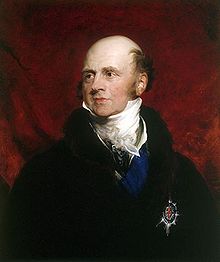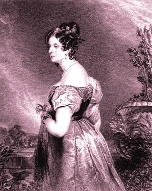John Russell, 6th Duke of Bedford
The Duke of Bedford | |
|---|---|
 Portrait of John Russell, 6th Duke of Bedford by Sir George Hayter in 1835 | |
| Lord Lieutenant of Ireland | |
| In office 12 March 1806 – 11 April 1807 | |
| Monarch | George III |
| Prime Minister | The Lord Grenville |
| Preceded by | The Earl of Powis |
| Succeeded by | The Duke of Richmond |
John Russell, 6th Duke of Bedford KG PC FSA (6 July 1766 – 20 October 1839), known as Lord John Russell until 1802, was a British Whig politician who notably served as Lord Lieutenant of Ireland in the Ministry of All the Talents. He was the father of Prime Minister John Russell, 1st Earl Russell. [1]
Background
Bedford was a younger son of Francis Russell, Marquess of Tavistock, eldest son and heir of John Russell, 4th Duke of Bedford. His mother was Lady Elizabeth, youngest child of Willem van Keppel, 2nd Earl of Albemarle and Lady Anne Lennox. [2]
Political career
Like most Russells, Bedford was a Whig in politics. He sat as Member of Parliament for Tavistock from 1788 to June 1790 and from December 1790 to 1802, when he was elevated to the Upper House on the death of his father. He served as Lord Lieutenant of Ireland during the Whig government of 1806–1807. He became, as did many of his party who were strong followers of Bonapartism, opposed to the Peninsular War, believing that it neither could nor should be won. He funded, along with his son, many anti-war publications. Bedford was sworn of the Privy Council in 1806 and appointed a Knight of the Garter in 1830.
Family
Bedford married firstly the Hon. Georgiana Byng, daughter of George Byng, 4th Viscount Torrington, in 1786. The marriage lasted 15 years and they had three sons:
- Francis Russell, 7th Duke of Bedford
- Lord George Russell
- Lord John Russell, Prime Minister of the United Kingdom and grandfather of philosopher Bertrand Russell.
There is evidence to suggest that Bedford also kept a mistress named Elizabeth Charlewood and had one child by her in 1797:
- Robert Russell, a carpenter from Bletchingley, Surrey.

After Georgiana's early death in October 1801, Bedford married secondly Lady Georgiana, daughter of Alexander Gordon, 4th Duke of Gordon, in 1803.[4] They had ten children, including:
- Lady Georgiana Elizabeth Russell (d. 22 March 1867), married Charles Romilly and had issue
- Reverend Lord Wriothesley Russell (11 May 1804 – 6 April 1886), married Elizabeth Russell, his second cousin once removed, died without issue
- Admiral Lord Edward Russell (24 April 1805 – 21 May 1887), married Mary Ann Taylor and died without issue
- Lieutenant-Colonel Lord Charles James Fox Russell (10 February 1807 – 29 June 1894), married Isabella Davies and had issue
- Lady Louisa Jane Russell (8 July 1812 – 31 March 1905), married James Hamilton, 1st Duke of Abercorn and had issue. Diana, Princess of Wales was his great-great-great-great-granddaughter through his daughter Lady Louisa Jane Russell
- General Lord Alexander Russell (16 September 1821 – 10 January 1907), married Anne Holmes and had issue
- Lady Rachel Evelyn Russell (1826 – 21 February 1898), married Lord James Butler and had issue.
The Duchess of Bedford was a great patroness of the arts, and had a longstanding relationship with the painter Sir Edwin Landseer, a man twenty years her junior. The Bedfords' marriage was nevertheless considered to be a very happy one.[5] Bedford was succeeded by his eldest son from his first marriage, Francis. The Duchess of Bedford died in February 1853, aged 71.[citation needed]

References
- ^ "RUSSELL, Lord John (1766-1839)". History of Parliament Online. Retrieved 3 June 2016.
- ^ According to the Oxford Dictionary of National Biography, Russell was born on 20 September 1766. However, the following entry in the parish registers of St Giles in the Fields, "John Russell of Francis & Elizabeth marquis & marchioness of Tavistock", dated 2 August 1766 for his baptism, would put his birth earlier.
- ^ Lotnotes for this painting
- ^ Biographical details: Georgiana, Duchess of Bedford, BritishMuseum.org; accessed 16 June 2015.
- ^ Trethewey, Rachel. Mistress of the Arts: the Passionate Life of Georgina, Duchess of Bedford. Headline Books 2003; ISBN 0-7472-5503-2
- ^ International Plant Names Index. J.Russell.
External links
- Hansard 1803–2005: contributions in Parliament by the Duke of Bedford
- Profile, thePeerage.com
- 1766 births
- 1839 deaths
- Lords Lieutenant of Ireland
- Dukes of Bedford
- Knights of the Garter
- Members of the Parliament of Great Britain for English constituencies
- British MPs 1784–90
- British MPs 1790–96
- British MPs 1796–1800
- Members of the Parliament of the United Kingdom for English constituencies
- UK MPs 1801–02
- Russell family
